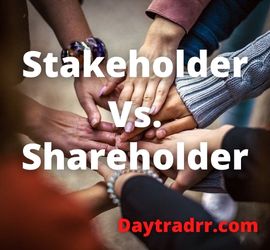Stakeholder vs Shareholder – What Investors Need to Know
 What is a stakeholder vs shareholder? When it comes to investing in a corporation, there are both. While they have similar-sounding names, their investment in a company is quite different. A stakeholder is anyone who has an interest in the success of a company while a shareholder actually owns shares. By definition, shareholders are always stakeholders in a corporation, but stakeholders are not always shareholders.
What is a stakeholder vs shareholder? When it comes to investing in a corporation, there are both. While they have similar-sounding names, their investment in a company is quite different. A stakeholder is anyone who has an interest in the success of a company while a shareholder actually owns shares. By definition, shareholders are always stakeholders in a corporation, but stakeholders are not always shareholders.
In other words, a shareholder owns part of a public company through shares of stock. Similarly, a stakeholder has an interest in the performance of a company. However, for reasons other than stock performance or appreciation. These reasons often mean that the stakeholder has a greater need for the company to succeed over a longer-term.
Stakeholder vs Shareholder A Closer Look
A shareholder is a person, company, or organization that owns at least one share of a firm. As a result, they have a financial stake in its success. A shareholder, for example, could be an individual investor who is expecting the stock price will rise as part of their retirement plan. Shareholders have the right to vote and influence a company’s management. In short, shareholders are the company’s owners. However, they are not liable for the company’s debts. This is different from owners of private firms, sole proprietorships, and partnerships. Those owners are personally accountable for the obligations of the company. For example, a sole proprietorship is an unincorporated business that has a single owner who pays personal income tax on the business’s profits.
Shareholders are the most common type of stakeholder in publicly traded companies. Clearly, shareholders are directly affected by a company’s performance. However, a shareholder can sell their shares and buy new equities. Ultimately, they do not need the company in the long run. Stakeholders, on the other hand, are committed to the company for the long term and for the greater good. Therefore, other groups must be considered stakeholders as well. For example, the suppliers in that company’s supply chain may suffer if the company no longer uses its services. Similarly, employees are stakeholders and rely on the company for income.
Stakeholder vs Shareholder – Key Differences
What is a Stakeholder?
A stakeholder is a person or entity who has a vested interest in the company’s success or failure. A stakeholder has the ability to influence or be influenced by the company’s policies and aims. Stakeholders can be both internal and external. Internal stakeholders have a direct relationship with the company because they work for it, own it, or invest in it. Employees, stockholders, and managers are examples of internal stakeholders. External stakeholders, on the other hand, are people who do not have a direct relationship with the company but may be affected by its activities. Suppliers, creditors, and community and public groups are examples of external stakeholders. Stakeholders can be:
- Owners and shareholders
- Employees of the company
- Bondholders who own company-issued debt
- Customers who may rely on the company to provide a particular good or service
- Suppliers and vendors who may rely on the company to provide a consistent revenue stream
What is a Shareholder?
A shareholder is an individual, organization, or institution that owns at least one share of a firm. Therefore, they have a financial interest in its success. Shareholders might be individual investors or major businesses who want to vote on a company’s management. If the company performs well and its stock price rises, the shareholder’s value rises. However, if the company performs poorly and its stock price falls, the shareholder’s value falls. Shareholders would prefer that the company’s management adopt activities that raise the share price and dividends. Ultimately, shareholders want management to continually improve the company’s financial status and share price. In short, shareholders are publicly-traded company owners. However, they are not liable for the company’s debts or other financial responsibilities. Creditors of the corporation cannot hold the shareholders accountable for any obligations owed to them.
- Preferred shareholder – Preferred stock owners typically do not have voting rights. This clearly limits their voice in the company’s future. They do, however, receive a fixed annual dividend payout (except under certain circumstances).
- Common shareholder – Dividends on common stock are variable, not guaranteed, and are set by the board of directors. If a company’s assets must be liquidated, common investors are paid last, after creditors and preferred stockholders have been compensated. However, unlike preferred shareholders, common shareholders have voting rights. This gives them considerable influence over management choices and business policy. People often prefer to invest in common equities rather than preferred stocks for this reason.
Investor and Shareholders Rights
Shareholders do not take part in the day-to-day running of the company. However, the company’s charter gives them some rights as owners of the company.
- Shareholder voting rights – One of the most important rights you have as a shareholder is the ability to vote your shares in company elections. Shareholder voting rights offer you the authority to elect directors at annual or special meetings. Your vote allows you to express your opinions to company management and directors on critical matters that may impact the value of your shares.
- Access to company financial records – One of these rights is the right to inspect the company’s books and financial records for the year. If shareholders have some concerns about how the top executives are running the company, they have a right to be granted access to its financial records.
- Right to sue directors and company officers – If shareholders notice anything unusual in the financial records, they can sue the company directors and senior officers.
- Allocation of proceeds – Also, shareholders have a right to a proportionate allocation of proceeds when the company’s assets are sold either due to bankruptcy or dissolution. However, they receive their share of the proceeds after creditors and preferred shareholders have been paid.
- Special Considerations.
What to know as an investor
One of your key rights as a shareholder is the right to vote for your shares in corporate elections. Shareholder voting rights give you the power to elect directors at annual or special meetings and make your views known to company management and directors on significant issues that may affect the value of your shares. Under state law, shareholders may vote at an annual or special meeting. However, since most people live hundreds of miles away from these meetings and are too busy to attend, the law permits shareholders to vote by “proxy” without being present in person. Most shareholders vote this way. During corporate elections, when you vote by proxy, you are authorizing someone (often members of the company’s management) to vote according to your wishes as reflected on the proxy card at the meeting. (Source: investor.gov)
Stakeholder vs Shareholder Theory
The shareholder vs. stakeholder question examines how firms engage with and hold themselves accountable.
- Shareholder priority – According to one point of view, a company’s first responsibility is to its shareholders. Therefore, its top aim should be to maximize profits.
- Stakeholder priority – On the other hand, a stakeholder priority advises that firms promote ethics and create value. This should be for all stakeholders and not just those who own stock. Along with the emergence of corporate social responsibility, or CSR, stakeholder theory has aided in the creation of better working environments and employee benefits. This is especially noticeable in industries with bad working conditions.
Stakeholder vs Shareholder Corporate Social Responsibility
Historically, corporations were exclusively accountable to their stockholders. This dynamic, however, has shifted in recent years. Many organizations have begun to recognize that, in addition to shareholders, the company must answer to a variety of other stakeholders in the business environment. For example, consider a corporation engaging in economic operations that consume freshwater. The company must consider measures to safeguard the social welfare of the community and the ecosystem. The corporation may participate in tree-planting exercises, supply purified drinking water to the community, and award scholarships to community members.
Corporate social responsibility (CSR), a self-regulating business model. It allows a firm to be socially accountable to itself, its stakeholders, and the public. CSR encourages businesses to consider the interests of all stakeholders. For example, companies can consider their environmental impact rather than making decisions based only on shareholder interests. The whole public is now considered an external stakeholder under CSR governance. As a result, CSR pushes firms to make decisions that promote social welfare. This approach can yield results above and beyond legal and regulatory constraints.
Up Next: What Is a Living Trust?
 A living trust is a legal document that, like a will, contains your instructions for what you want to happen to your assets when you die. However, unlike a will, assets can transfer to a beneficiary while avoiding probate.
A living trust is a legal document that, like a will, contains your instructions for what you want to happen to your assets when you die. However, unlike a will, assets can transfer to a beneficiary while avoiding probate.
A living trust is a legal contract established during an individual’s lifetime. It is a way to manage and protect assets that will ultimately benefit your named beneficiaries after you pass away. A designated person, the trustee, is charged with managing the individual’s assets for the benefit of the eventual beneficiary. A living trust is intended to facilitate the transfer of the trust creator’s or settlor’s assets while avoiding the frequently complex and costly legal procedure of probate. A trustee is designated in living trust agreements as the person who has possession and control of the assets and property that flow into the trust.




